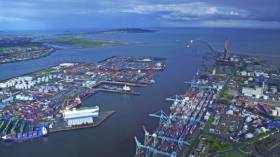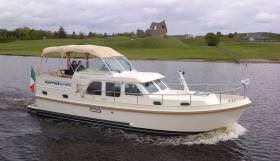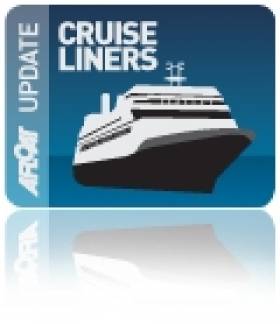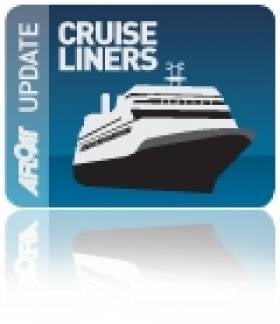Displaying items by tag: Cruise Ireland
Dublin Port’s decision to reduce cruise liner visits from 2021 has sparked concern among the wider tourism industry in Ireland.
As covered last month on Afloat.ie, rising freight volumes and the need to create space due to Brexit will mean a prioritisation of freight over tourism at the capital’s port into the next decade.
However, the move is being regarded as a major blow to a sector on the rise, and one that would have a knock-on effect for businesses across the country.
Speaking on RTÉ Radio 1’s Today with Sean O’Rourke yesterday morning (Tuesday 12 March), Excursions Ireland managing director Niamh McCarthy said the port’s decision is risking the loss of a business worth €50 million annually to the economy nationwide.
McCarthy, a fonder of industry body Cruise Ireland, said cruise turnarounds — whereby thousands of passengers change over at one port for a lengthy stay to explore the country — “are the one sector of this industry that has been growing at an alarming rate.
“Last year Dublin Port handled five Celebrity turnarounds,” she said, explaining that each brought many thousands of passengers ashore to explore and spend money in cities and towns across Ireland.”
“Dublin’s decision to do this will have an absolute catastrophic effect on cruise in Ireland”
McCarthy said she is headed to the US next week for “emergency meetings” with cruise companies who are concerned about the lack of certainly around berth availability in the coming years.
“If they don’t come to Dublin, they won’t come to the other ports,” she warned.
“Are we the only country in the world that wants to turn that business away?”
Dublin Port is currently seeking to take back land leased for “non-core activities” that it says is required to accommodate customs checks and inspections post-Brexit, as The Irish Times reports.
With its first hire this Saturday, River Shannon Boat hire firm Carrickcraft is launching the first of its new steel–built Linssen vessels just in time for the 2017 season.
As Afloat.ie reported earlier, Ireland's largest cruise hire charter company is expanding its 115–boat fleet with the addition of five Dutch built boats over the next few seasons.
The first of these new steel yachts was on trial this week as pictured above at Clonmacnoise in Co. Offfaly.
Cruise-Ireland placed an order at Linssen Yachts for five new yachts, which involves a turnover of more than €1m. The aim of this long-term collaboration is to extend the Cruise-Ireland fleet with several new Linssen Yachts every one or two years. Cruise-Ireland is a combination of two of the oldest yacht charter companies in Ireland: Carrickcraft and Waveline Cruisers.
New boats will go into the Cruise-Ireland bases in Banagher, two in Carrick and one on the Shannon one-way route.
Season 2017: Record Number of Cruise Calls to Visit Irish Ports
#RecordCalls - Irish ports in 2017 will have their busiest ever cruise ship season with over 300 vessels scheduled to visit ports and harbours, large and small, around the island. The record year further extends the success of the past three years which has seen a 50% increase in the number of cruise calls to Ireland.
Details of the record numbers were released by Cruise Ireland during its attendance at Seatrade Cruise Global, the world’s largest expo for the cruise industry which is taking place this week in Fort Lauderdale, Florida.
Cruise Ireland, an All-Ireland Marketing cooperative, made up from the island’s ports, shipping agents, excursion companies and visitor attractions, however, believes that there is scope for even greater significant increases in the number of cruise ship visits.
Speaking at Seatrade, Joe O’Neill, current Chairman of Cruise Ireland and Belfast Harbour’s Commercial Director, said: “In the past 10 years the island of Ireland has outperformed the European market place; recording average annual growth in cruise passenger numbers of 13% against the European average across the same period of 9%. Feedback from cruise lines on their experience of visiting Ireland is very positive and encouragingly the cruise industry is projecting that demand for Ireland as a cruise destination will continue with a 14% growth forecast to 2020.”
“The island of Ireland continues to deliver world class experiences for the international cruise visitor and with Titanic Belfast recently being voted as the world’s leading tourist attraction we have a broad range of world class, must see attractions, right across the island i.e. Guinness Storehouse, Blarney Castle, Giant’s Causeway and the Cliffs of Moher to name but a few. Awareness of Ireland as a cruise destination has grown significantly in recent years however we are confident that by aligning our marketing efforts with the international marketing campaigns managed by the island’s national tourism agencies - Tourism Ireland, Failte Ireland and Tourism NI, that there is a huge opportunity for us to reach an even wider cruise audience.”
Currently most cruise ships to the island call at ports in the major cities of Dublin, Belfast and Cork, but smaller ports such as Galway, Derry-Londonderry, Waterford, Killybegs and Dun Laoghaire are also attracting calls, spreading the economic impact of the cruise industry across the whole island.
Mr O’Neill added: “The members of Cruise Ireland have been attending Seatrade for over 21 years now and we are realising the fruits of our efforts with the 300+ calls the island will receive this year. It is essential that we are here to ensure that the potential of the island is raised among each of the Executives from the Cruise Lines represented at this conference to make sure that Ireland remains firmly fixed as a destination of choice offering multiple calls in close proximity and ultimately an exceptional visitor experience.”
Cruise ships calling at Irish ports range from the largest vessels operating in Europe such as the Royal Princess (see photo) with over 5,000 passengers and crew to smaller expedition and luxury vessels with just 50 passengers.
Cruise Industry Body To Discuss Funding Changes
#Cruises - Cruise Ireland's members will meet in January to discuss controversial proposals to change the way the organisation is funded.
At November's board meeting of the industry body representing interests in the Irish cruise industry, the Port of Cork's commercial manager Michael McCarthy charged that Ireland's biggest ports in Dublin and Cork should no longer be Cruise Ireland's primary funders.
McCarthy cited the wish for greater contributions from other tourist venues that reap the biggest business from Ireland's cruise traffic.
Echoing his sentiments, Cruise Ireland chair Eamonn O'Reilly noted that the body's current subscription model of 'the bigger you are, the more you pay' was no longer tenable in an increasingly competitive cruise marketplace - in light of plans by Dun Laoghaire, among other ports, to attract cruise liners.
O'Reilly, who is chief executive of the Dublin Port Company, proposed of a flat membership fee of €10,000 - which was objected to by a number of those present.
And though the matter was deferred for further discussion in the New Year, O'Relly shared Dublin Port's position that it would not not commit to funding Cruise Ireland under the current model beyond 2014.
Other matters discussed at November's meeting included a review of Cruise Ireland's marketing strategy at important international trade shows, in order to more effectively sell Ireland as a key European cruise destination.
Cruise Ireland's next meeting will take place on 21 January 2014.
Strong First Half 2012 Cruise Call Season to Ireland
#CRUISE LINERS – According to the Irish Maritime Development Office (IMDO), a number of calls by international cruise ships to Irish ports, many on their maiden calls to this country, have visited within the first half of 2012.
Irish Ports had confirmed visits for 202 international cruise liners this year and so far they have welcomed a broad collection of vessels including Princess Cruises 'Grand' class liner Grand Princess in January which lead to the disembarkation of an estimated 4,000 visitors to Dublin Port.
Also calling to the capital as previously reported was the $250m luxury cruise liner MSC Lirica carrying almost 3,000 passengers and Cobh during the month of August. She is due to make a repeat call to both ports this weekend, firstly to the capital and then sailing overnight to Cobh.
Over the past two years, it has been estimated that the cruise ship industry has contributed €20.3 million to the island of Ireland.
With the increase in bigger liner ships calling to this country there are clear indications that the contribution that the cruise industry is making to the Irish economy will have a significant influence on the economic opportunities for the hinterland's of Irish host ports, and could be worth a potential €60 million over the next few years.
Most recently, at the Cruise Europe Conference 2012 held at Royal Greenwich, London, Captain Michael McCarthy of the Port of Cork, was unanimously elected Chairman of Cruise Europe. Captain McCarthy is currently serving as Commercial Manager with the Port of Cork Company.
Commenting on the Irish cruise business, the newly elected chairman of Cruise Europe, Captain Michael McCarthy said: "There are many indirect economic and tourism benefits to Ireland from the cruise sector, as well as the benefit of introducing Ireland to new markets and growing business opportunities. Cruise visits help to showcase Ireland's world class shore products, destinations and highlight all that Ireland has to offer visitors."
He continued: "One of Ireland's advantages is the strategic and geographic spread of its numerous ports, many of which are in close proximity to world class tourism destinations and it is with this in mind that Ireland will be promoted with the North and Atlantic European destinations to develop thriving and 'must see' destinations".
































































